By Mathew Friedman
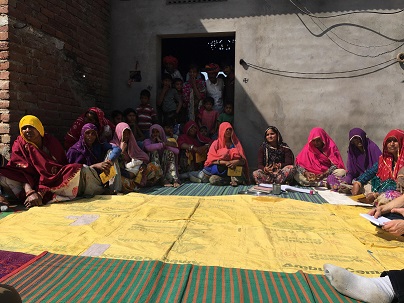
“I’m not sure how you want to phrase this, but can you ask whether men feel threatened at all?”.
I can tell from Dr Chetan Choithani’s widening eyes that the challenge of asking something like this to the group of around a dozen women, with some men and children lurking in the doorway, is going to require more than a linguistic translation.
We’re sitting with one of the eight women’s self-help groups in Kanwarpura, a village of around 1,000 inhabitants. Our guide here is a representative of SRIJAN, the NGO that helped set this group up seven years ago, and continues to support it.
“I might… take another one whilst I figure out how to word that” says Chetan, before moving on to a question about SHG structure. Fair enough.
I am, however, curious. We have spent the first half of this field school hearing about the manifestations of a deeply patriarchal society, and yet here, in rural Rajasthan of all places, is a group of women who talk like they’ve never heard anyone tell them not to. It’s a total misnomer that women’s empowerment leads to the opposite for men (a message that the global North needs to learn as much as anyone), but I can’t help but think that this is all too amazing to be true.
Because it is truly amazing. This SHG of ten women has built up a savings stock of 60,000 rupees (around AUD$1,200), which they lend to one another to purchase livestock, repay outstanding loans, cover medical expenses, and build infrastructure like wells. The Agriculture and Development School, run by this and three other SHGs, claims responsibility for doubling crop yields in four years through training and soil testing. The local government school is now preferred to private alternatives because pressure from the Village Development Committee, a council of 16 women representing all the village SHGs, have made teachers attend their classes. Kanwarpura has 24/7 electricity, reliable clean drinking water, toilets in every inhabited house, relatively reliable government services, and a corruption trial against an official that clearly underestimated what he was up against.
I am aware that as a group of foreigners, the goal is to impress us, and that the SRIJON lens is necessarily limited. For example, we walked through a neighbourhood belonging to a group from a ‘scheduled tribe’ but didn’t speak to any of its inhabitants, nor to any woman excluded from the SHGs, or any officials. Nor, for that matter, to any men.
“Men don’t feel threatened,” comes the eventual translation, with a very logical explanation. “They encourage these women. It’s a good source of income and credit when the family needs live stock or something like that. Once they saw that the SHG worked, there’s a lot more respect”. The women nod along.
Even taking all of the successes mentioned above with a pinch of salt, it’s clear these women are respected, by men, none of whom tried to speak for them, both public and private banks, who have lent the Manrag SHG four times their savings stock, but most evidently by themselves. These women probably would have had less food and more work than their brothers, little education, and would have had to relocate to an entirely new village during their arranged marriages to become the lowest with the hierarchy in their new families, almost all of which would be in the lower social and economic echelons within their village. Yet these women sat in front of us with studiously kept account books, interrupting one another in their excitement to discuss financial, social, and agricultural strategies.
This model for development is not perfect, and hardly a drop in the ocean of India’s 863 million-strong rural population, but it does one thing brilliantly: it recognises the amazing resource that already exists in all communities. It’s well documented that women are the key to successful grass roots development, and with supportive institutional structures, room to grow, and just a little self-belief, these women seem to have grown like oaks.
Author: Elizabeth Hill
Invisible India
By Laura Stewart
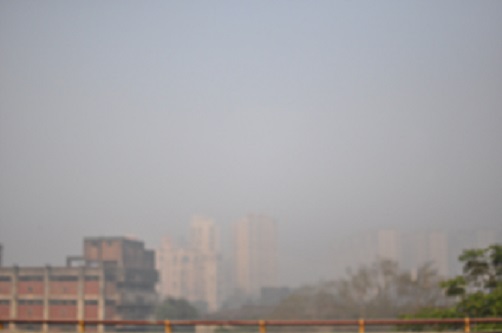
India has a population of 1.32 billion people. Homelessness, gender-based violence and malnutrition are part of the national story often not told. In the midst of such a large population many are forgotten, left to fade as if they had never existed.
In Mumbai it is a rarity for the smog to clear enough for you to see more than one layer of the city. Our gaze is always obstructed. As we begin to study the city, its institutions, and its history, it becomes apparent that this is a nation of invisible people, a nation of people we chose not to think about, chose to ignore.
As a western woman arriving in the Indian context I initially viewed invisibility as a problem. Visibility and recognition is necessary for social change. In India, however this must be rethought. Our guide in Dharavi moved to Mumbai because he wanted to disappear. Involved in a love marriage invisibility meant he and his wife could avoid being targeted by the police, dragged in for questioning, and, in more extreme cases of these love marriages, killed.
In Rajasthan as well I was faced with this invisibility-by-choice. Many women chose to cover their faces when in public. For a western woman such a practice is often interpreted as oppressive. In India, where violence against woman is prevalent, it is a more understandable choice. If you are a woman, too much negative attention from the opposite sex, or those in power, can have devastating consequences. Invisibility, in this context, provides a kind of independence, where no one knows who you are and your actions in public are less likely to lead to attract unwanted attention. Invisibility provides women protection, but it is also enforced by an oppressive system.
For many, however, invisibility is not a choice. Slum dwellers are ignored and relocated in never ending attempts to erase them from the landscape of the city. For those living below the poverty line, or on the streets, a unique identity number is crucial. Without formal documentation people are not able to access health services, social services, or rations. In Australia our passports, official papers and tax file numbers allow us to be seen in a thousand ways we never think about, but in India it is often those who need this visibility the most who don’t’ have it.
More concerning than those we are forced to ignore are those we choose to not to see. As a young child knocks on the window of our bus, attempting to sell us some form of plastic goods, we avert our eyes, finding it easier to ignore than deny. As a woman begs us for food we turn away. The truth is with so much poverty we cannot bare to see it all. To function we learn not to see.
One solution to the risk of individuals fading completely into to smog is to form groups. A collective that votes together is more likely to create change than an individual. However, sometimes, these groups become a vehicle for political exploitation. When you have a leader telling you how to vote your voice begins to disappear along with your identity. You are no longer an individual, but a member of a community – a Muslim, a Buddhist, a women, or BPL (living below the poverty line). You become a number in a voting bank. Or worse, you are ignored altogether. You are invisible because you remain only one in 1.3 billion, conceivable only as a statistic.
Train Travel: A Site for Reflection and Learning
By Holly Fraser
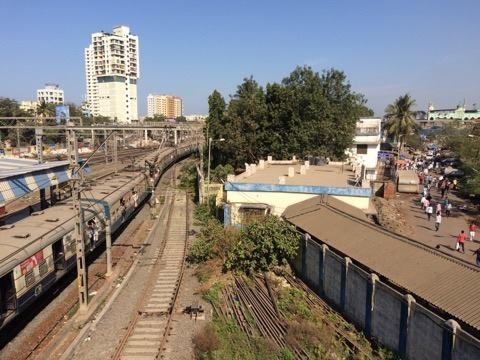
One of the most striking features about Mumbai for an Australian visitor is the amount of people. With an estimated population of 22.5 million and growing, Mumbai is currently the most populous city in India. To put that into perspective, it is nearly equivalent to the entire population of Australia! An integral part of any major city such as Mumbai is the transport. Throughout our study tour of India so far we have experienced various modes of transport including buses, taxis, rickshaws and the train. Catching transport can be a mundane activity, but it reveals a lot of interesting things about a place.
Just when I thought I had left the train woes of Sydney behind, I was confronted by more chaos but on a whole new scale when I arrived at a suburban railway station in Mumbai. It was peak hour and there were streams of people walking, shouting and shoving in all different directions. As the trains pulled up to the station they were packed with people hanging out the open door carriages. There were even people jumping off the train and trying to board before it had come to a stop. It was not hard to see why the rail network of Mumbai is known as the lifeline of the city.
Every day over seven million people in Mumbai travel on the train and for many it is a necessary way to reach their place of employment. However, as we have been made aware through our lectures and course readings, it can often be a safety issue for women. Seeing train carriages reserved for women only, a relatively new initiative in Mumbai, really re-enforces this. Any change that enables women to access employment is a welcome change in my opinion, but at the same time, it may be a band aid solution to a much larger societal problem.
Despite having train carriages dedicated specifically to women, there appeared to be far more men than women waiting to board the train. This observation is perhaps not surprising given that in a lecture on employment we learnt that there were less women employed in urban areas than men. It also reflects our knowledge of the high number of women not in the labour force, which includes those engaged in unpaid housework and care duties.
The train was not only a method of getting to work, but for others it was an important means of employment. Inside the train there were people making their way through the carriages selling small goods. Outside the train, there were people collecting rubbish distributed across the tracks. As I learnt from a local, these people are known as rag pickers. Their survival depends on selling the plastic for just 4 rupees a kilogram to the local recycling industry. Both the sellers on the train and rag pickers on the train tracks are considered to be part of the informal economy, which as I recently learnt on this field study, comprises a massive ninety-four percent of India’s labour force.
Although a fairly short train ride, upon reflection, it speaks to the themes we have been learning about over the past week such as urban growth and development, women’s issues and employment.
Smart City? Or Not So Much…?
By Jade Lisbin
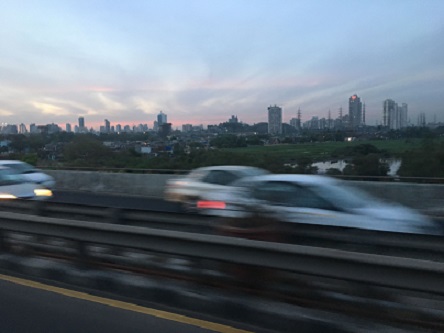
Only 31 per cent of India’s population lives in an urban area. But this amounts to 400 million people. 23 million people live in Mumbai alone. With this exorbitant number of people, I wonder, how can technology be used effectively to improve the sustainability of a city, particularly a city like Mumbai?
In recent times, new cities in India have been built to replicate those in rich countries and incorporate technology. These are called ‘smart cities’. A smart city is generally described as optimising the use of Information and Communication Technology to monitor and maximise efficiency and increase the safety of all aspects of urban infrastructure whether that is schools, transport systems, shopping centres or waste management systems. The aim is to minimise resource consumption and costs in an attempt to make the city more eco-friendly and sustainable. In theory, this sounds like a great idea, right?
The problem with this model, as we learned from one of our Professors at Tata Institute of Social Sciences (TISS), is that rather than trying to improve an already existing city, private developers and consulting companies have started creating new cities on ‘uninhabited’ land. With this, comes environmental degradation, political corruption, further social exclusion and a whole realm of other issues. I can see similarities between this approach and the dominant consumer lifestyle in which it is now easier to buy a new product rather than fix an old one. This same approach is taken to the evolution of India’s ‘smart cities’. But it comes at a cost.
Lavasa is an Italian inspired, privately owned town built on the model of a smart city a few hours from Mumbai. It demonstrates many of the issues we have been learning about such as locking out the poor while creating new homes for the rich. Lavasa is an extreme example of the approach to urban planning. But perhaps there are alternatives. Rather than creating a whole new city, investment would be better focused on improving and rehabilitating local development plans within already existing cities.
From an ethical perspective, I find myself wondering why was it is okay for countries in the global North to use all the resources they like while putting pressure on countries in the global South, like India, to limit their resource use.
How do you envisage the future of India’s development? Do you see more ‘smart cities’ popping up around India?
Slum Tourism: An Ethical Dilemma
By Ben Robinson
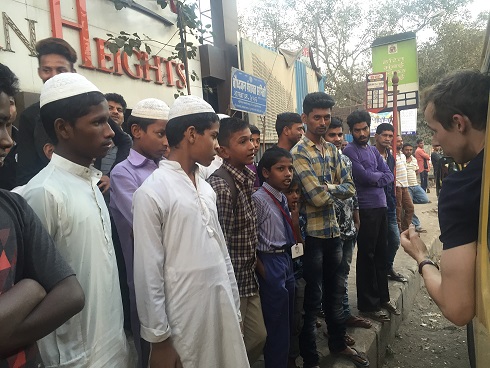
“The locals are used to it. The main benefit is for tourists who change their perceptions” claimed our tour guide, Daksh, as we walked through the winding alleys of Dharavi.
On Sunday, I went on a paid walking tour of Dharavi, along with members of our group. Dharavi is India’s biggest slum with one of the highest population density in the world. In the week leading up to the tour, and since, there has been lively debate about the ethics of slum tourism. On one hand, there was a desire to see what we had been learning about in class, while also potentially benefiting the local community by providing funds to tourist operators. On the other hand, there were concerns it could be voyeuristic, invasive, and an aestheticisation of poverty. This raised a number of questions about the appropriate role of travellers within developing countries, and where the line lies between seeing things ‘first-hand’, and being intrusive.
The tour itself was informative and engaging. We were first taken through a commercial area, surveying a number of leather, textile and pottery industries, before going to a residential area then a local school, where 80 per cent of the profits of the guided tours are sent. Apart from small children who ran up to us, our interactions with locals were passive and detached. As one of many wide-eyed tour groups going through that day, there was a feeling of indifference toward us. Daksh, our tour guide, was excellent, but I left the tour wondering: was that experience necessary to get a holistic, balanced picture of what life in Dharavi is like?
I think part of our preconceptions about informal communities is formed because of the language we use to describe them. The terms ‘slum’, ‘informal’ and ‘squatter’ are problematic and negative, defining urban life in terms of a terms of a deficit. In economics, the informal economy is that part of the economy not accounted for in national accounts. The discourse of informality is framed as the ‘other’ within the formal economics framework and formal urban planning processes. But there is no sense in which informality precedes formality. Cities are built from informal processes as much as ‘formal’ ones. In India, 93 per cent of the economy is ‘informal’ and Dharavi has an estimated annual turnover of $1 billion.
I think the popularity of slum tourism, both in India and around the world, is also linked to a trope within western culture about the ‘authentic’ traveller who visits ‘exotic’ places and ‘gets off the beaten track’. Tourists construct a humanitarian Self through their engagement with suffering in developing countries. I’ve often heard stories where tourists present their travels as essential for coveted experiential knowledge while depicting locals as the true beneficiaries of the tourists’ self-discovery. While this may not have been exactly the case for our group, as we are here on a study tour, I think these cultural narratives do affect us.
All travel involves an element of voyeurism. We enjoy seeing new places and we grow from experiences that broaden our understanding of the complexity of the world. But reflection is needed when there is power dynamics between foreigner and local, when an experience is passive and observing, rather than active and mutually engaged.
There may not be definitive answers for Dharavi, or slum tourism generally. I think this depends on a balance between the actions and intentions of tourists, the views of locals about foreigners coming into their homes, and how the tour company operates within the community that they are profiting from. But, as a foreigner, I think there is a responsibility to be cautious, reflect, and be aware of the spaces you occupy.
Young India and the Pressure to Succeed.

I come from a Bangladeshi family and have always appreciated the family and community aspect of South Asian culture. This has given me a support network, spanning the globe, of extended family and friends who are genuinely interested in my wellbeing. But close community connections bring with them a number of expectations. For some young Indians family and community pressure has a devastating cost.
Youth suicide rates are higher in India than many other countries. Every year, 30-40 young people out of every group of 100,000 decide to take their own lives. Young people between the ages of 15 and 29, who have so much to experience, to love, to learn, have their lives cut short. One of the reasons behind this is family pressures.
According to National Crime Records Bureau (NCRB) data, 2015 saw 43,852 young Indians take their own lives, with almost 50 per cent of these deaths attributed to family or societal pressures. These pressures take many forms: secret love affairs, failure to marry, and even failure in exams. Notions of success have in many ways imposed unrealistic expectations on a generation that is struggling to compete in an increasingly hyper-competitive India.
Every year, millions of young men and women enter the job market, competing over the limited number of ‘regular’ jobs on offer. Only around 10 per cent of new jobs fall into the formal or organised sector. This has led to a phenomenon described by some scholars as ‘timepass’ where students remain in tertiary education for years while searching for employment. But as disappointment turns to apathy and discontent, this inability to secure to employment and marriage can lead to distress and in the worst cases suicide.
In a country where almost half the population is under 30, a ‘demographic dividend’ is expected to be a great boon to the economy. But the conditions of extreme competition and a culture of family and community expectation is having a terrible impact on many youth. Investment in mental health facilities are urgently required to address this national crisis.
Women and Public Spaces
By Myra Opdyke
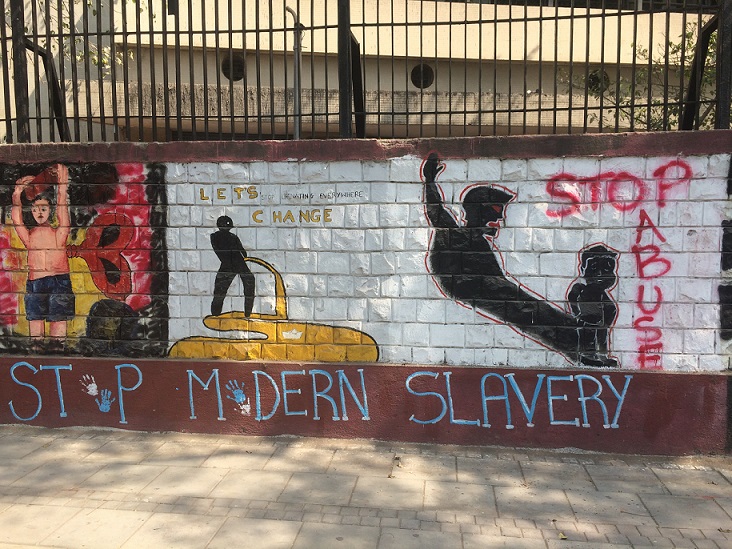
Two things have surprised me during my time in India: men urinating in public, and the lack of women in public spaces. Travelling around, I have found myself in places where groups of two or more men are out with their friends. But until I got within a day’s drive of Mumbai I had not seen groups of women out with their friends. When I first came across a group of women out together, it wasn’t a group of two or seven, but a group of over twenty… safety in numbers, I suppose.
However moving in such a large group is not always practical, which brings me back the issue of open defecation. In class we have been learning about many aspects of Indian society, particularly the complex interactions of caste, class and gender and how they shape people’s individual agency. I have been particularly struck by how open defecation is a common practice in many parts of India. This means that women often wait until nightfall to relieve themselves. Under the cover of darkness they walk out of their villages and into the fields. But this can be a very dangerous activity. Cases of rape are common.
In some areas, public awareness about the health impact of open defecation is on the rise. One group of women have begun a movement whereby they refuse to marry a man unless there is a toilet installed at his house! Sounds like a great idea. I can’t help wondering, however, whether this is a bargain that most women are able to make. India, as we have been learning, is a deeply stratified society and women are rarely able to make such claims against prospective bridegrooms. When dowry deaths number in the thousands each year, it is hard to imagine that women are in a position to negotiate sanitation facilities.
When I arrived in Mumbai from my Northern travels, I was suddenly in a different world. It was a strange combination of the India I had seen so far, mixed with British colonial buildings and women walking around freely. In some ways, I felt like I could almost be back in Sydney. It is the smells that set Mumbai apart. For a stretch of half a block, you may be smelling spices, flowers and fruit. But in a moment, you find yourself suddenly inhaling the smells of urine, defecation, and rot.
In India, a city can feel foreign compared to the surrounding rural areas. While some women in the city eat at fine dining restaurants, others are risking their lives as they walk to a field late at night. On this peaceful evening, gazing out of my seventh story window as the sun sets over the slums, greenery and multi-story buildings nearby, I can’t help but wonder how the women of Mumbai city are living. I wonder how their different backgrounds have converged to bring them here, and how the city will treat their daughters.
A Clean Green India for Who?
By Jennifer Horton
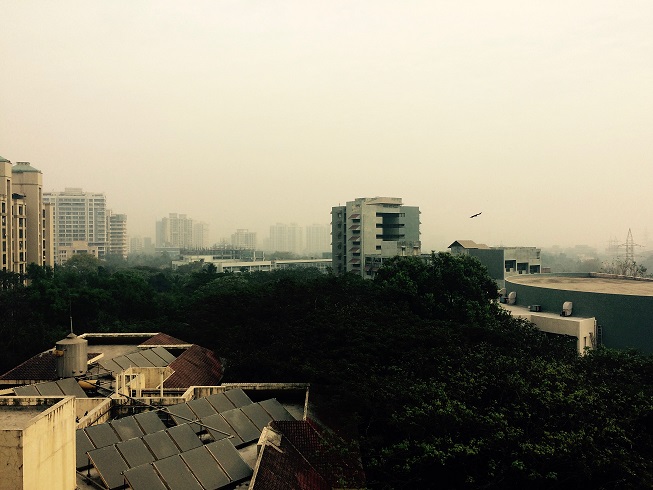
If you ever find yourself waking up on the seventh floor of the Tata Institute in Mumbai, this is what you should expect to see. Today’s weather forecast, ‘hazy’. Tomorrow’s — ‘cloudy’. After that, ‘smoky’. You get the picture.
Down on the ground, the situation is no better. Traffic controllers arm themselves with black face masks. Congested roads fade into a hazy mist. As Mumbai’s smog levels creep higher and higher, the question of how to reduce dirty emissions from vehicles is becoming increasingly difficult to ignore, for citizens and government alike.
Earlier this week, the Maharashtra government revealed its plans to address the issue of pollution — through a comprehensive electric vehicle plan. The Cabinet has cleared a new policy that encourages the manufacture and use of green vehicles through tax rebates for electric car buyers, financial incentives for manufacturing companies, and subsidies for new charging stations. Owners of electric vehicles will be exempt from road tax and registration fees, and offered a subsidy of up to 100,000 rupees. The government claims that the new policy will create 100,000 new jobs within the state. For greenies and climate activists alike, this sounds like a dream come true, right?
There is no doubt that electric cars are a useful strategy for reducing vehicular emissions. If every car and bike in India were replaced with an electrical equivalent, the transformation would be unprecedented. Smog could be a thing of the past. In India’s goal to go completely electric by 2030, it’s a bold step.
But I can’t help but wonder — of all the bold government steps that India is in need of it, is this the right one? Electric vehicles look good on paper. But looking out this window, it’s hard to agree this policy is adequate. At best, it’s a signal of the government’s decision to prioritise environmental action. At worst, it’s yet another example of government policy that perpetuates inequality in India. What sense does it makes to subsidise electric cars, if the roads they’re driving on are riddled with pot holes and lined with slums? Why should 100,000 people get cheap Teslas when millions of others are still vying for plumbing?
Last week, I would have jumped at any proposal designed to promote electric cars. They’re clean, they’re efficient, (most importantly) they look cool. But after a few days of walking the streets of Mumbai, I’m struggling to summon any enthusiasm for a policy that seems to disregard the needs of so many millions of Indian citizens, to whom electric cars are a distant dream. There is no question that improving air quality and reducing emissions should be a government priority. But the introduction of electric vehicles won’t stop the huge amount of biomass burnt by slum-dwellers, nor will it reduce the enormous emissions from India’s coal and oil power plants. Electric cars are a fantastic tool for clean energy — provided they come hand in hand with energy policy that meets the needs of Indian society beyond the richest 10%.
Reading about India’s environmental policy back home, I never considered it in relation to the growing divide between India’s have and have-nots. But being here now, it’s clear that any steps taken by the Indian government to address pollution must be taken as part of a larger mission — to reduce India’s crippling inequality. At its heart, getting rid of smog isn’t about reducing carbon footprints, meeting climate action goals or creating a cleaner planet. It’s about improving quality of life for the citizens of India. Looking out at the streets of Mumbai, it’s pretty clear that the citizens of this country are in need of a lot more than a few cheap Teslas. Electric vehicles will undoubtedly play a significant role in reducing vehicular emissions sometime in the future. But right now, let’s not forget whose future we are talking about when we speak of a clean future for all of India.
Not the Gateway to India I had envisaged
By Alexander Vaughan
Arriving in Mumbai I was truly surprised. I had heard that Mumbai was a lively, cosmopolitan city, with disorganised traffic, Bollywood and ever-growing wealth disparities. But on exiting the bustling Chhatrapati Shivaji Terminus (CST) in the Fort district, I was surrounded by Victorian gothic architecture. I found it hard to believe I was in India and not wandering around Europe. I have a basic understanding of Indian history, and have read of the influence of the East India Company and the British Raj, but I did not expect to see the colonial influence in such an overt form.
Near to CST are the hustling markets which I had anticipated, with locals exchanging rupees for cheap and delicious pav bhaji, onion pakora, samosas, masala chai and a widespread selection of local fruits and vegetables. Around me buildings are crumbling, streets are chaotic and rubbish piles up. Temples, mosques and various national monuments rise tall. The call to prayer from the local mosque is a low hum. Vibrant Hindu and Islamic dress are in abundance.
But it is the influence of the British which really takes me aback. Having travelled briefly in the South of India I find the British influence in Mumbai stark by comparison. The architecture, the language, government and educational system, the transport infrastructure and cricket are all on display and tell the story of colonialism.
But India is not simply a cricketing nation and a democracy based on the British system undergoing rapid development. The Republic of India has only existed for 70 years and is a federation of States with different languages, customs and ways of life which lay within boundaries drawn up at Independence. Behind the visual façade I encountered when I exited CST lays a culture with deep rooted systems and customs, which have existed on the sub-continent for thousands of years.
In our classes so far we have been introduced to the intertwined structures of caste, class and religion and the role they play shaping Indian society. Progress is complicated. Women have less opportunities and face structural hardships. Adding to the intricacies of Indian culture and its many sub-cultures, is the sheer scale of India – how to manage 1.3 billion people?
I need to remember that India has a dynamic and contested history, and that the learning we are receiving inside and outside the class is embedded in this history. I expect the field school will peel away a few of the layers, make things clearer, and organise a few pieces in the greater puzzle that is India. There is so much to learn and consider. I am excited and everyone in the group is engaged.
Political Economy and geography students start Indian field school

On Monday, 17 students majoring in political economy and geography arrived in Mumbai for a three week intensive field school experience. The field school is run by the Department of Political Economy and Geography in collaboration with three Indian universities/research institutions: the Tata Institute of Social Sciences (TISS), the Indian Institute for Health Management Research (IIHMR), and the Central University of Karnataka. The field school involves an intensive, integrated three-week program of classes and field visits addressing the political economy of development and environmental management in modern India. Students are engaged by Indian scholars and civil society groups working on issues of geo-political, economic and environmental importance and gain firsthand insight into the daunting challenges facing one of the most important nations in the contemporary global economy.
The first week of the program will be run at the TISS campus in Mumbai. Students will stay on campus at the Tata Institute of Social Sciences and participate in tailored classes and city field visits developed by the local academic staff, in close collaboration the University of Sydney convenors. This component of the field school will address India’s ‘national story’ of development, and raise questions about the contested process of economic development, environmental sustainability and social inequality.
In the second week of the program, students fly up to Jaipur in Rajasthan. Here they will stay with our partner organisation, the Indian Institute for Health Management Research. The IIHMR has specialist expertise in the delivery of social programs to poor and remote rural parts of India. This week’s program will provide an opportunity to see rural India firsthand and will include day trips to local villages and national parks where ystudents will begin to develop a critical appreciation of the contested relationship between economic development, human security and ecological sustainability.
The third week of the program takes us to Hyderabad where students will drive a few hours out to the Central University of Karnataka, in the regional city of Gulbarga. In this part of Northern Karnataka students will be exposed to some of the most pressing issues facing Tribal communities in India, and their efforts for political and economic security within a rapidly modernizing global economy.
The blog posts that follow will capture the student experience of contextualized learning and their reflections.

